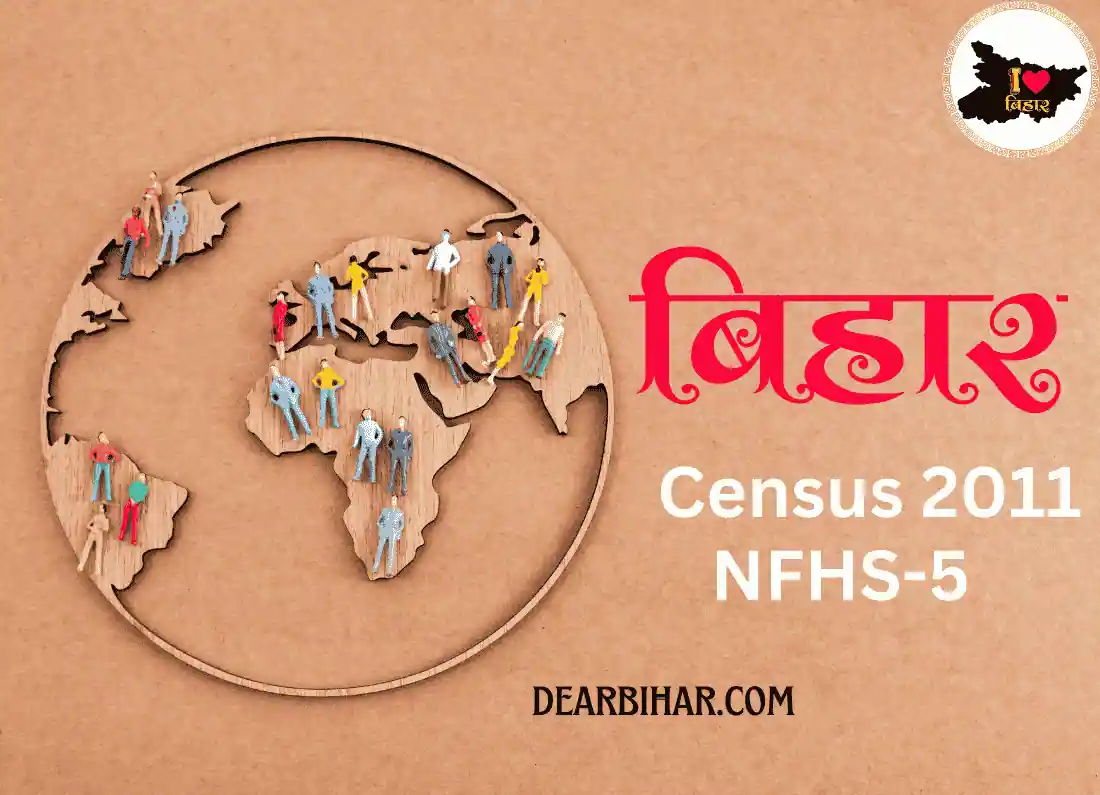Bihar Census 2011 : बिहार भारत का सबसे गरीब और सबसे कम साक्षरता दर वाला राज्य है। बिहार के बारे में आप कितना जानते हैं ? इस post में मैं आपको बिहार जनगणना 2011 और बिहार के राष्ट्रीय परिवार स्वास्थ्य सर्वेक्षण के बारे में जानकारी दूँगा।

Table of Contents
Demographics bihar census 2011

Population of Bihar in bihar census 2011
What do you mean by Poulation ?
जनसंख्या का अर्थ है किसी विशेष क्षेत्र में रहने वाले कुल निवासियों की संख्या। 2011 की जनगणना के अनुसार बिहार की जनसंख्या लगभग 10.41 करोड़ है।
नीचे दी गई तालिका में, हमने 5 सबसे अधिक आबादी वाले जिले और 5 सबसे कम आबादी वाले जिले को उनकी जनसंख्या के साथ शामिल किया है।
| Most Populated District of Bihar | Least Populated District of Bihar |
| Patna-5,838,465 | Sheikhpura– 636,342 |
| East Champaran-5,099,371 | Sheohar– 656,246 |
| Muzaffarpur-4,801,062 | Arwal– 700,843 |
| Madhubani-4,487,379 | Lakhisarai-1,000,912 |
| Gaya-4,391,418 | Jehanabad-1,125,313 |
Population Density of Bihar
What is population density ?
1 वर्ग किलोमीटर क्षेत्र में रहने वाले लोगों की संख्या जनसंख्या घनत्व है।
2011 की जनगणना के अनुसार, बिहार राज्य का जनसंख्या घनत्व 1,106 प्रति वर्ग किमी है। नीचे दी गई तालिका में हमने सबसे अधिक जनसंख्या घनत्व वाले 5 ज़िले और सबसे कम जनसंख्या घनत्व वाले 5 ज़िले दर्शाए हैं।
| Most Population Density | Least Population Density |
| Sheohar-1880 | Kaimur-488 |
| Patna-1823 | Jamui-568 |
| Darbhanga-1728 | Banka-674 |
| Vaishali-1717 | West Champaran-753 |
| Muzaffarpur-1514 | Rohtas-763 |
Literacy Rates bihar census 2011
| Highest Literacy Rates | Least Literacy Rates |
| Rohtas-73.37 % | Purnia-51.08 % |
| Patna-70.68 % | Sitamarhi-52.05 % |
| Bhojpur-70.47 % | Katihar-52.24 % |
| Munger-70.46 % | Madhepura-52.25 % |
| Aurangabad-70.32 % | Saharsa-53.20 % |
Sex Ratio bihar census 2011
| Highest Sex Ratio | Lowest Sex Ratio |
| Gopalganj-1021 | Munger-876 |
| Siwan-988 | Bhagalpur-880 |
| Saran-954 | Sheohar-893 |
| Kishanganj-950 | Begusarai-895 |
| Nawada-939 | Patna-897 |
Marital Status – bihar census 2011
| Married | Widowed | Seperated | Divorced | Overall |
| 46,302,047 | 3,297,891 | 75,805 | 21,627 |
National Family Health Survey (NFHS)
What is National Family Health Survey ?
राष्ट्रीय परिवार स्वास्थ्य सर्वेक्षण (NFHS) भारत में आयोजित एक बड़े पैमाने पर, बहु-दौर का सर्वेक्षण है, जिसका उद्देश्य विभिन्न स्वास्थ्य और परिवार कल्याण संकेतकों पर डेटा एकत्र करना है। यह देश में स्वास्थ्य और पोषण पर जानकारी के सबसे व्यापक स्रोतों में से एक है। NFHS महत्वपूर्ण डेटा प्रदान करता है जो नीति निर्माण, कार्यक्रम नियोजन और स्वास्थ्य और परिवार कल्याण कार्यक्रमों के मूल्यांकन में मदद करता है।
NFHS प्रजनन क्षमता, मृत्यु दर, मातृ एवं शिशु स्वास्थ्य, पोषण और परिवार नियोजन पर विश्वसनीय और तुलनीय आंकड़े उपलब्ध कराता है।
NFHS 5 report for Bihar
- बिहार में, 4/5 से अधिक परिवार (84%) ग्रामीण क्षेत्रों में हैं।
- औसतन, एक परिवार में 4.8 सदस्य होते हैं।
- 23 प्रतिशत घरों का मुखिया महिलाएं हैं।
- 19 प्रतिशत जनसंख्या महिला-प्रधान परिवारों में रहती है।
- Eighty-six percent of households in Bihar have household heads who are Hindu.
- चौदह प्रतिशत घरों के मुखिया मुस्लिम हैं।
- आधे से अधिक परिवार (57%) एकल(nuclear) परिवार वाले हैं।
- 43 प्रतिशत जनसंख्या गैर-एकल(non-nuclear) परिवारों में रहती है।
Caste Wise Percentage
- More than half of households (53%) in Bihar have household heads who belong to an other backward class.
- one-quarter (24%) belong to a scheduled caste.
- Four percent of household heads belong to a scheduled tribe.
Good Achievement of Bihar
- Eighty-six percent of persons have an Aadhaar card.
- Bihar have basic drinking water service, and 99 percent of households use an improved source of drinking water.
- Almost all households (96%) have electricity.
- Ninety-eight percent of households in all urban households (97%) and most rural households (93%) in Bihar have a mobile phone.
- Ninety-six percent of households have a bank or post office account.
- Three-quarters (76%) of births take place in a health facility (mostly a government facility), and one-quarter (24%) of births take place at home.
- Nearly three-quarters (71%) of children age 12-23 months received all basic vaccinations against six major childhood illnesses (tuberculosis, diphtheria, pertussis, tetanus, polio, and measles).
Some special facts
- More than one-third (36%) of Bihar’s population is under age 15.
- one-third (34%) of households in Bihar live in a pucca house, 54 percent live in a semi-pucca house.
- one-quarter (27%) of households own either a motorcycle or a scooter.
- BPL cards are held by 55 percent of households.
Education- Schooling- Literacy
- literate persons are those who have either completed at least standard 9 or passed a simple literacy test conducted as part of the survey.
- 55 percent of women age 15-49 and 76 percent of men age 15-49 are literate.
- two-fifths of women (39%) and 18 percent of men age 15-49 have never been to school.
- Only 16 percent of women and 28 percent of men age 15-49 in Bihar have completed 12 or more years of schooling.

- In Bihar, 32 percent of boys and 35 percent of girls age 2-4 years attend preschool.
- Preschool attendance is highest among scheduled caste households (34%)
- Preschool attendance is highest in Munger district (53%) and lowest in both Araria and Khagaria districts (22%).
Negative Reality of Bihar
- Thirty-one percent of men age 25-29 years got married before attaining the legal minimum age of 21.
- Total fertility rate (TFR) in Bihar is 3.0 children per woman.
- At current fertility rates, women with no schooling will have an average of 1.6 more children than women with 12 or more years of schooling (a TFR of 3.8, compared with 2.2).
- Muslim women will have almost one child more than Hindu women (a TFR of 3.6, compared with 2.9)
- women age 15-19 in Bihar, 11 percent have already begun childbearing, that is, they have already had a live birth or are pregnant with their first child.
- Forty-three percent of children under age five years are stunted, or too short for their age.
Research shows that waiting at least three years between children reduces the risk of infant mortality and has a positive impact on maternal health.
Read This Also:
Rajgir International Cricket Stadium no 1 in the Bihar latest
Tobacco Consumption in Bihar
- Nearly half (48%) of men and 1 percent of women, age 15-49 use some form of tobacco.
- Used most by men are khaini (37%), gutkha or paan masala with tobacco (15%), cigarettes (12%), paan with tobacco (5%), and bidis (2%).
- In Bihar, among adults age 15-49, a negligible proportion (0.1%) of women and 17 percent of men drink alcohol.
- Most men who drink alcohol drink it less than once a week (53%), or about once a week (37%) and 10 percent drink almost every day.
women empowerment in india
- Only 18 percent of all women age 15-49, compared with 75 percent of men, were employed in the 12 months preceding the survey.
- More than three-quarters (77%) of women have a bank or savings account that they themselves use.
- In Bihar, 51 percent of women have a mobile phone that they themselves use.
- In Bihar, 41% of women age 20-24 years got married before attaining the legal minimum age of 18 years.
- Young women who had no schooling are more than three times (25%) as likely to have begun childbearing as young women with 12 or more years of schooling (8%).

- Thirty-seven percent of women agree that a husband is justified in hitting or beating his wife under some circumstances.
- In Bihar, 39 percent of women age 18-49 have ever experienced physical violence, and 8 percent have ever experienced sexual violence.
Thanks For Visiting Dear Bihar


One Reply to “Bihar Census 2011, NFHS-5 का चौकाने वाला डेटा”